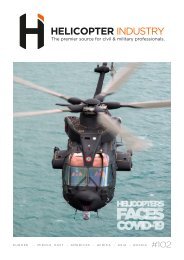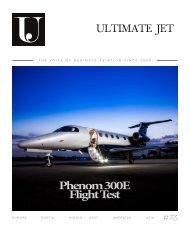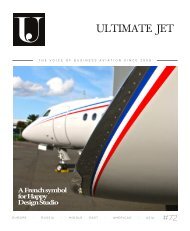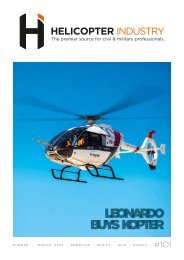Helicopter Industry #103
You also want an ePaper? Increase the reach of your titles
YUMPU automatically turns print PDFs into web optimized ePapers that Google loves.
HELICOPTER INDUSTRY I FAREWELL I<br />
AN EFFICIENT BUT AGING MACHINE<br />
With four machines still in flight, the 34F flotilla carried out<br />
the Lynx’s latest mission last July, during an operational<br />
mission in support of the strategic oceanic force for SNLE’s<br />
nuclear-powered ballistic missile submarines. Despite<br />
its intrinsic qualities and the possibility of an upgrade,<br />
the withdrawal of the Lynx has become a necessity in<br />
recent years, as François Chaput points out: «The age of<br />
the aircraft no longer allows it to be maintained in sufficient<br />
operational conditions. The maintenance of the Lynx has<br />
proved increasingly difficult, often forcing mechanics to carry<br />
out retro engineering.» The Navy will thus have kept up, until<br />
the end, the maintenance capacities of the aircraft at the the<br />
operational level, within the flotilla in Lanvéoc, and at the<br />
aeronautics industrial workshop (AIA) in Cuers-Pierrefeu. At<br />
the same time, the aircraft will have benefited throughout<br />
its working life from industrial monitoring by Leonardo, a<br />
company created in 2000 from the merger between Italy’s<br />
Agusta and Britain’s Westland. However, its operating costs<br />
will impede on further modernisation. According to a report<br />
submitted to a Member of Parliament last July, the aircraft’s<br />
flight hours have gone from 14,000 to 22,000 euros in four<br />
years for an annual maintenance cost of 17.7 million euros.<br />
And, for an availability rate of less than 16%! This was just<br />
enough to decide on the withdrawal of the beast, not without<br />
regrets according to its crews, who, at the closure of the 34F,<br />
will be reassigned to different units.<br />
A NEW ERA<br />
If the withdrawal of the Lynx marks the end of an era, it is<br />
also synonymous with renewal for the French Navy. The<br />
ASM mission has already been taken over by the NH90<br />
Cayman Marine for several years, notably within the 33F and<br />
31F on board multi-mission frigates (FREMM). The Cayman<br />
Marine, which entered service with the «Royale» in 2011,<br />
thus takes over the entire range of missions carried out by<br />
the Lynx. And, according to some authorities, it is sometimes<br />
not without difficulty, when faced with a last-generation<br />
machine, where it is difficult to maintain operational.<br />
Despite a few uncertainties, the NH90 is in fact becoming<br />
the spearhead of the on-board helicopter component. The<br />
Navy has also opted for another Airbus <strong>Helicopter</strong>, the H160,<br />
and the withdrawal of the Lynx has made it possible to<br />
ratify the project to upgrade the helicopter component by<br />
implementing an interim fleet consisting of H160s and N3<br />
Dolphins. According to François Chaput, « this project has<br />
a promising future and the Lynx’s retirement will also make it<br />
possible to invest in it on a long-term basis. »<br />
If the time of the feline’s retirement has indeed sounded, its<br />
second life within the national museums, in order to preserve<br />
this flying heritage, still remains to be defined. As CF Chaput<br />
underlines, « calls for the delivery of some of the cells to the<br />
historical museum of the helicopter, in Dax, to the museum of<br />
the association of the friends of naval aeronautics in Rochefort<br />
and, why not, to the Museum of the air and space installed on<br />
the airport of Paris - Le Bourget. »<br />
HI I 20









